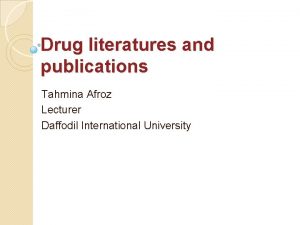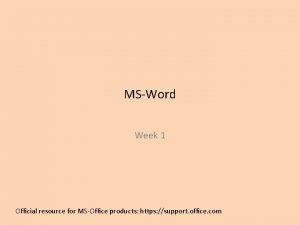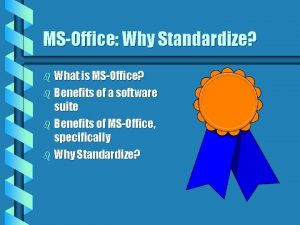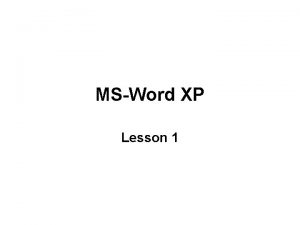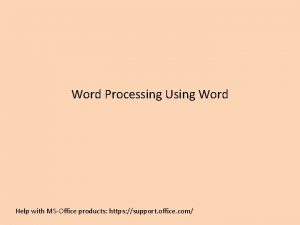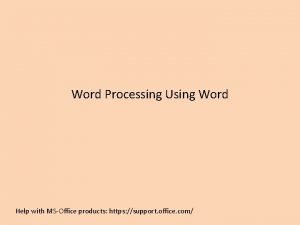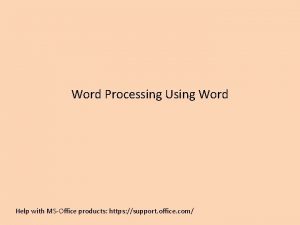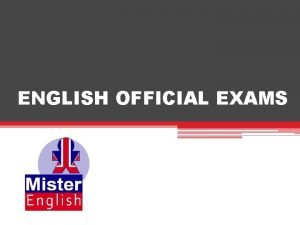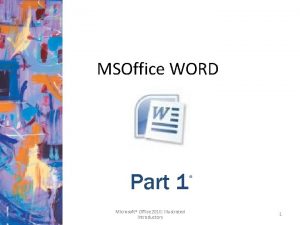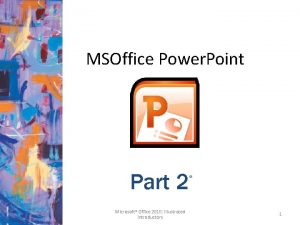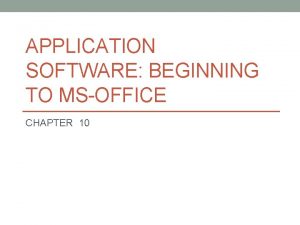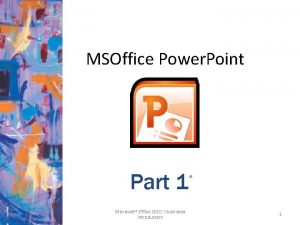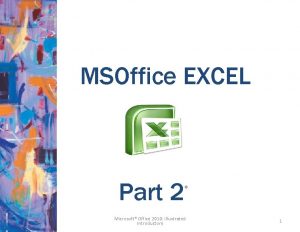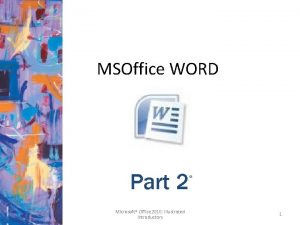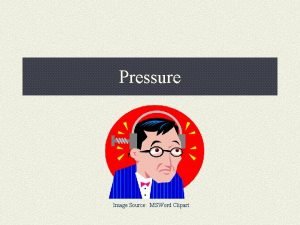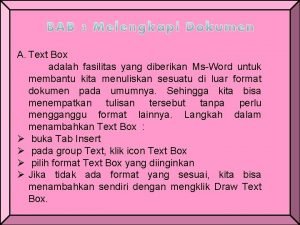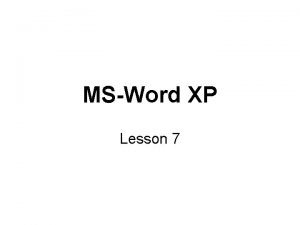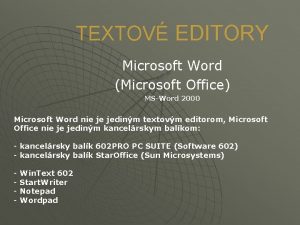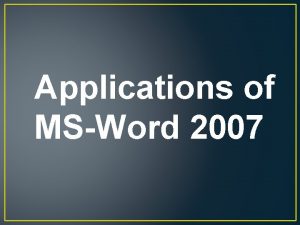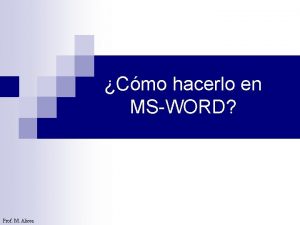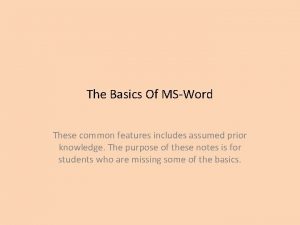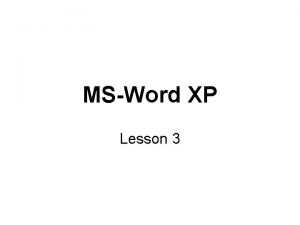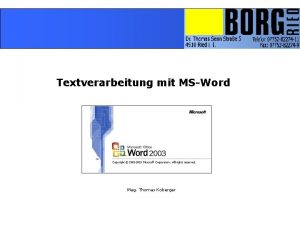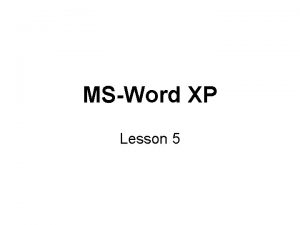MSWord Week 3 Official resource for MSOffice products
























- Slides: 24

MS-Word Week 3 Official resource for MS-Office products: https: //support. office. com

Activities In Tutorial • TA demos: – Used for more complex features (typically multiple steps are required). – The tutorial instructor will show on the projector/instructor computer each step for running the feature in Word. • Student exercises: – Used instead of TA demos for simpler features. – You will have already been given a summary of how to invoke the feature and the purpose of the exercise is to give you a chance to try it out and get help if needed.

Mail Merge • This feature can be used to create customized documents that are based on a starting template e. g. emails, letters, mailing labels etc. • Inputs to the merge: – “Original main document” a Word document that provides the starting template for the parts of the document that will be same e. g. “Sincerely: Peter Griffon” for a letter. – “Data source” contains information for the parts that will be customized e. g. Excel spreadsheet, Access database etc.

What You Get From The Merge • Outputs of the merge: – Default output (this is what you will submit for the assignment) • The original main document will contain the customized documents. • You can ‘click’ through all the different letters and see how the main document has been customized. • Changes can be made in the customization.

What You Get From The Merge (2) – Optional output: • Generated if you select “finish and merge” • Creates a new Word document that only contains the customized results (e. g. the sequence of customized letters that can be printed or sent). • Only the individual letters can be customized. –Looks the same as manually typing all the individualized letters (which is why it won’t merit any credit because it doesn’t demonstrate mastery of the mail merge feature). • Not needed for assignments.

Mail Merge Example: TA Demo • Example files can be found in the tutorials link for this week under the subfolder ‘mail_merge_example’ • Since this is a longer multi-step process, students can download this example from the tutorial portion of the course website and follow along as the tutorial instructor works through the process. – There will also be student exercise to follow: • Contents of this folder: – Original main document (Word document): form_for_creating_recommendations-ORIGINAL – Data source (Excel spreadsheet): students

Original Main Document CUSTOMIZATIONS FROM THE MERGE Salutation Student name Extra endorsement (GPA 3. 0 and above) Qualifications

Data Source

Example Customized Letter

Starting The Mail Merge • (In this case the original main document and the data source has already been created, normally you would have to create those yourself). • Open the original main document in Word. • Select: Mailings tab->Start Mail Merge->Step-By. Step Mail Merge Wizard

Mail Merge Step 1: Select Main Document Source • Under the options on the right hand side of the Word window select “Email message” and the ‘next’

Mail Merge Step 2: Creating The Starting Document • In this case the starting document has also been created and you have opened it via Word. • Select the default (“Use the current document”) and select ‘next’

Mail Merge Step 3: Select Recipients • This is when you can select the data source (customized for recipients). • In this case you will use the Excel spreadsheet called ‘students’. • Select the default source “Use an existing list” and click ‘OK’ • Select ‘Browse’ (navigate to the ‘students’ spreadsheet) • Click ‘next’

Mail Merge Step 4: Write The Letter • You will customize the original main Word document with the appropriate fields of the data source:

Mail Merge Step 4: Write The Letter (2) • 4 A: Salutation – Click on the line at the very top of the letter – Select “Greeting line” – You can use the default “Dear Sir or Madam”

Mail Merge Step 4: Write The Letter • 4 B: Student name – Click on the line containing the text “I am writing this recommendation for. ” • Click just in front of the period. – Select ‘More items’ – Then ‘insert’ “Given names” – Follow this by an ‘insert’ of “Last name”

Mail Merge Step 4: IF-THEN-ELSE • 4 C: Include a conditional endorsement – Students whose GPA is 3. 0 or greater will have the text “This student was above average. ” added to the end of the letter. – Click two lines below the text “This person was a student of mine and completed the following degree: “ – Select under the ‘Mailings’ tab: Write & Insert Fields group: Rules->IF-THEN-ELSE

Mail Merge Step 4: IF-THEN-ELSE (2) • 4 C: Include a conditional endorsement (continued) – A popup dialog box comes up – Under the “Field name” option select “GPA” – Under the “Comparison” option select “Greater than or equal” – Type ‘ 3’ into the “Compare to” field – Type ‘This student is above average’ in the “Insert this text” field – (Leave the “Otherwise insert this text” field blank.

Mail Merge Step 5: Finish • Select the “Complete the merge” option and save the updated Word document. • You can see the individual results under: – Mailings tab->Preview results group->Preview results (and then click forward or backward)

Mail Merge: Do Not Finalize The Process For Any Assignments (If Applicable) • “Finish and Merge” can be used in ‘real life’ to produce a Word document that contains all the merged letters (for printing or emailing). • However, if you only submit the finalized the document there is no way that the marker can tell that you actually performed a mail merge. – The different letters cannot be “clicked through” (previous slide). – (The results could have been produced by simply typing the results into Word). – To see the result of the finished document using this example see: incorrect_finish_and_merge_document

Opening A Word Document Using Mail Merge • Because the Word document is connected to another document you will get a prompt each time that you open it. – Just select “Yes”

Mail Merge: Student Exercise • Same folder as the TA demo, use the following files: – Original main document (Word document): mail_merge_student_exercise-ORIGINAL – Data source (Excel spreadsheet): courses

Mail Merge Student Exercise • Open the Word document and use it as the starting template • Using the mail merge feature add the following in the merged letters. “To whom it may concern” • • e. g. CPSC 203 Text varies: For ‘CPSC’ courses = Highly recommended! For all others = A UC course. e. g. J Tam

Copyright Notification • “Unless otherwise indicated, all images in this presentation were created by James Tam. ” slide 24
 Types of drug compendia
Types of drug compendia Week by week plans for documenting children's development
Week by week plans for documenting children's development Functional vs innovative products
Functional vs innovative products Pepsi vs coke brands
Pepsi vs coke brands Resource leveling is the approach to even out the peaks of
Resource leveling is the approach to even out the peaks of Perbedaan resource loading dan resource levelling
Perbedaan resource loading dan resource levelling Redogör för vad psykologi är
Redogör för vad psykologi är Geometriska former i förskolan
Geometriska former i förskolan En lathund för arbete med kontinuitetshantering
En lathund för arbete med kontinuitetshantering Bra mat för unga idrottare
Bra mat för unga idrottare Ledarskapsteorier
Ledarskapsteorier Offentlig förvaltning
Offentlig förvaltning Datorkunskap för nybörjare
Datorkunskap för nybörjare Fredsgudinna pax
Fredsgudinna pax Vilken grundregel finns det för tronföljden i sverige?
Vilken grundregel finns det för tronföljden i sverige? Rita perspektiv
Rita perspektiv Ministerstyre för och nackdelar
Ministerstyre för och nackdelar Plats för toran ark
Plats för toran ark Nationell inriktning för artificiell intelligens
Nationell inriktning för artificiell intelligens Bästa kameran för astrofoto
Bästa kameran för astrofoto Sju principer för tillitsbaserad styrning
Sju principer för tillitsbaserad styrning Nyckelkompetenser för livslångt lärande
Nyckelkompetenser för livslångt lärande Sju för caesar
Sju för caesar Rim dikter
Rim dikter Handledning reflektionsmodellen
Handledning reflektionsmodellen
